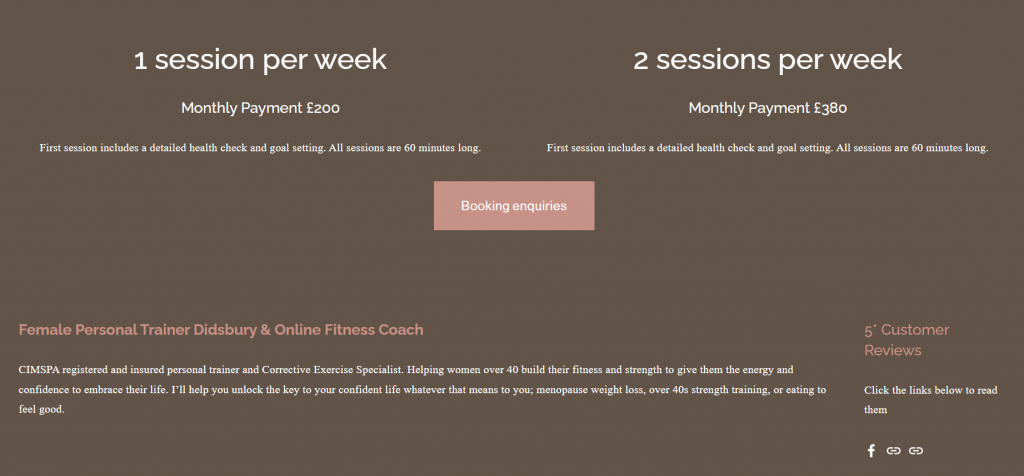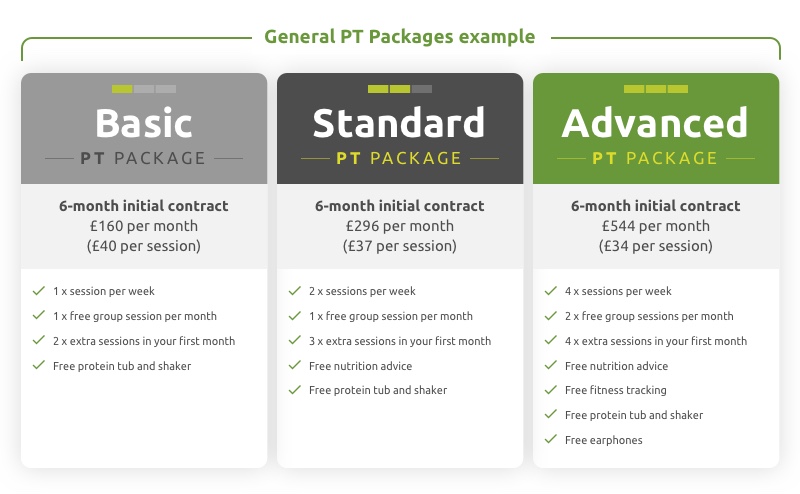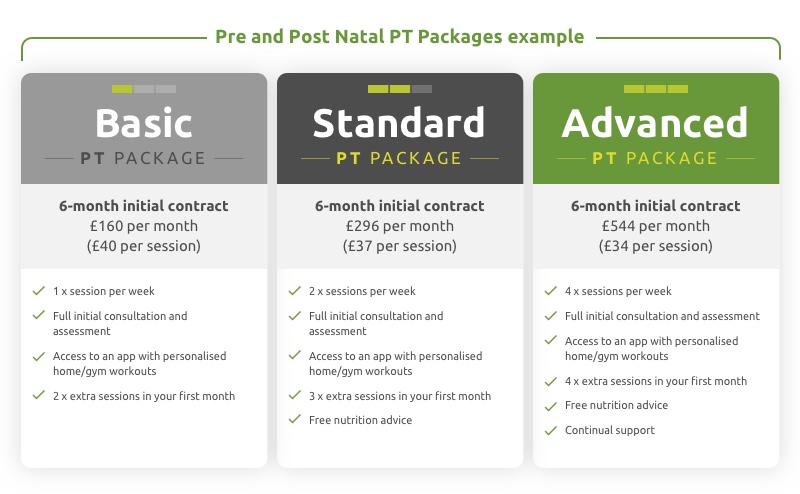How to design personal training packages (step-by-step)

If you’re new to the fitness industry, it can be
difficult to know how to create personal training packages that sell.
Building a client base is difficult when you’re just
starting, and it can still be challenging even with a few years of experience.
After all, marketing and selling your services is
time-consuming and a different skill altogether compared to coaching your
clients’ fitness.
Here you’ll find everything you need to build your client base and boost retention. You can kill two birds with one stone through your pricing structure when you know the right method.
1. Know your niche
Nothing is more important than defining your unique
selling point when developing personal training pricing packages.
Knowing the niche fitness market you’re targeting
means you can build your packages with your client base in mind.
This means they’ll be better suited to your
potential clients, who will then be more likely to sign up for your services.
If you present a general pricing structure that
doesn’t include a variety of services or extras to benefit from, clients won’t
see the value in what you’re selling.
To give a quick example, let’s compare the two personal trainer pricing structures.
This pricing structure was created by a PT who doesn’t necessarily target a niche fitness market.
They also sell block
sessions rather than presenting clients with a recurring monthly subscription,
and there’s no mention of any additional services such as nutritional advice or
group fitness classes, for example.
Block sessions carry
an end date and a potential gap in your income if clients decide not to rebook
when their sessions end.
That’s not to say
this can’t be a successful business model if you have plenty of potential
clients in your area and you’re happy to put a lot of work into reselling your
services.
But zoning in on a
particular group of potential clients can make your life a lot easier and
significantly boost your income.
If you want to secure
a long-standing client base that doesn’t require constant reselling, then let’s
look at an alternative pricing structure.

This personal training package example is from The Over 40s Personal Trainer, a PT who runs sessions from her home in Didsbury.
The clue is in her business name, but she primarily
works with women over 40 looking to improve their fitness.
This information is displayed alongside her pricing
packages, where she mentions her expertise in things such as menopause weight
loss and eating to feel good.
Presenting her packages in this way means that
anyone in this demographic will naturally be drawn to them, as they’re designed
with them in mind.
They know that if they sign up, they’ll benefit from
specialised fitness and nutrition advice to aid their training, rather than
that of your regular personal trainer at the gym.
Many PTs are beginning to see the value in this kind
of business model. Not only does having a niche bring in more clients, contrary
to popular belief, but it truly boosts retention when they can’t find such specialised
advice elsewhere.
To find your niche, try this simple process:
analyse your competitorsidentify a gap in the marketresearch this ‘gap’establish and market yourself as the go-to expert on this topic
There’s obviously some hard work involved in
following this, but the steps are simple when you break them down.
Related: The best niche fitness markets personal trainers can take advantage of
2. Demonstrate value
Following on from our point above, it’s important to
communicate the value of your services to potential clients.
While this includes specialist knowledge in your
chosen area, you can make your personal training packages even more appealing
by throwing in extra perks.
This is less about fitness and more about selling
your services to clients. After all, you’re running a business, and you need to
tap into your sales knowledge at times if you want it to be successful.
So, what extra value can you add to your personal
trainer packages once you’ve chosen an area of the market to specialise in?
Here are some ideas:
free nutrition advice free access to bootcampsfree group training sessionsprotein powder/supplementsfitness journalmeal prep kit
The word ‘free’ will draw the attention of potential
clients, as they’ll feel they’re getting more for their money.
Offering these additional services will be cost-effective
for you and require little effort on top of your main service. So, it won’t
affect your profit from signing new clients up.
Adding extra value to your services on top of your
unique selling point creates a personalised selection of personal training
packages for your potential clients.
This places you way ahead of competitors, especially
if you’re operating in your local area rather than online.
Chances are many of them are selling block sessions
or short-term bootcamps aimed at the general public, and they’re unaware of how
they could improve their business model.
Related: A PTs guide to building a client base from scratch
3. Create your personal training packages
Now that you know what makes personal training
packages successful, it’s time to create your own.
We’ve put together two examples to help you out based on everything we’ve discussed. Feel free to use them as a template when designing your own, and don’t forget to check out our tips on selling your packages below.
Examples of strong personal training packages:

Notice how the price per session becomes lower as the monthly amount increases.
This draws attention to the fact the client is getting a better deal by spending more per month and encourages them to opt for the higher price.
The number of free services and gifts increases with the price, too, even though the client is technically only paying for the sessions. You should keep these extras valuable to the client yet minimal for yourself.
Here’s an example of how a set of packages targeted at pre and post-natal clients could look:

What you include in your packages will rely on your own areas of expertise and your target client base, but we hope these examples shed some light on what a strong and highly marketable pricing structure looks like.
Remember, never devalue your services by adding discounts to your actual prices.
They should always stay the same–your time is valuable and offering extra sessions or token gifts is a great way around signing clients up through discounts.
Although, offering a 10% discount to clients who pay in full for the 6-month minimum duration is a great tip. If a client pays in full for the Standard package at £296 per month, for example, that’s £1,776 on the spot.
This is great for you and makes your packages easier to sell without devaluing them if a client asks for a discount. But more on this below.
4. Tips for selling your personal training packages
The final step of creating your personal training packages is knowing how to sell them.
Effectively promote your packages
Once you’ve created your personal trainer price
list, you need to get it in front of clients. Places you can display your
pricing structure include:
your websiteyour social media pagesgym noticeboardcommunity noticeboardslocal shop windows
While there are various promotion methods, you
should focus on those most relevant to your business.
For example, if you’re operating mostly out of your
local gym or a purpose-built client training area in your own home, you’ll want
to focus on attracting potential clients in your area.
It would make more sense to partner with local
businesses and spread the word of your services that way, rather than putting
your efforts into online marketing.
However, this can still be useful if you stick to
optimising your website and socials around location-based keywords.
On the other hand, it wouldn’t make much sense to
focus on marketing to your local community if you’re looking to attract online
clients. Instead, you would focus on growing traffic to your website and social
channels using niche-specific keywords.
You can learn more about becoming a successful online PT here.
Another fool proof way of promoting your personal
training packages that applies to all business models is through
referrals.
Encouraging your clients to ‘refer a friend’ works
extremely well, as it’s mutually beneficial. You gain more clients, and they
benefit from incentives for promoting your services.
For example, you could offer £50 cash to clients who
successfully refer a friend. That’s a huge incentive for them, and it’s a small
price to pay for getting a new client signed up for a recurring monthly
package.
Remember that the reward doesn’t need to be cash—you
could offer any benefit you feel your client would value.
Related: What is a typical personal trainer salary?
Create urgency when price presenting
This applies to in-person and online PTs and is perhaps
one of the most important aspects of selling your personal training packages.
Implying that your product won’t be available with
such a good deal in the future creates a sense of urgency and encourages
potential clients to act fast.
It makes your services seem more desirable compared
to competitors, especially if you do your research and make sure you present
your packages this way. It will ultimately increase your sales rate.
But, how do you achieve this sense of urgency?
Setting a deadline for your offers is a fool proof way of signing up new
clients on the spot.
It reduces the likelihood of a client making an
excuse, such as ‘I need to speak with my partner first’ before signing up,
which happens more often than you’d think.
For example, you could state, ‘I have an offer for
the Advanced Package ending today. It’s 10% off if you pay in full, and I’m
throwing in free nutrition advice as part of the plan.’
Or, if you’re promoting your packages online,
incorporate this offer into the copy on your website or social media
description.
This form of discount gives the client a push
towards finalising the sale without you having to devalue your services, as
reducing the monthly rate can significantly reduce your income and annoy other
clients who are currently paying more.
If they pay in full for the Advanced Package at a
monthly rate of £544 with a 10% discount, that’s £2,937 on the spot. Not bad
for one client.
BONUS TIP: Using social proof to emphasise the value and
popularity of your product is a great way to follow this up.
You could say, ‘twelve people have already signed up
for this offer today, so you don’t want to miss out!’.
It would help if you also displayed testimonials and
reviews across your website and social media channels, as this form of social
proof is incredibly powerful for customers making a purchase decision.
Related: How to blog as a personal trainer
Include a clear CTA
This is important if you’re promoting your personal
training price list online.
Your CTA, or ‘call to action’ should be as clear as
possible and direct potential clients straight to the point of contact.
Try not to use vague language such as ‘get in
touch’. Instead, show them exactly how to contact you, so they don’t think
twice before enquiring.
Here’s an example of a strong CTA to use on a social
media post:
Want to get this offer before it ends? DM me today, or call (insert phone number), and I’ll get you signed up straight away.
From this, the clients know where and how to contact you, and that they need to do so promptly.
Personal training is a hugely rewarding and
lucrative career path, but things can go wrong. That’s why you may want to
consider protecting yourself through insurance.
With Insure4Sport, specialist personal trainer insurance is designed to cover you if your equipment is lost, damaged, or
stolen or a client makes a claim against you.
If you suffer a serious injury while carrying out
your PT sessions, you’ll also be covered for loss of earnings for up to 52
weeks.
Discover more about how we can help here, or click the button below to get an instant online quote.








